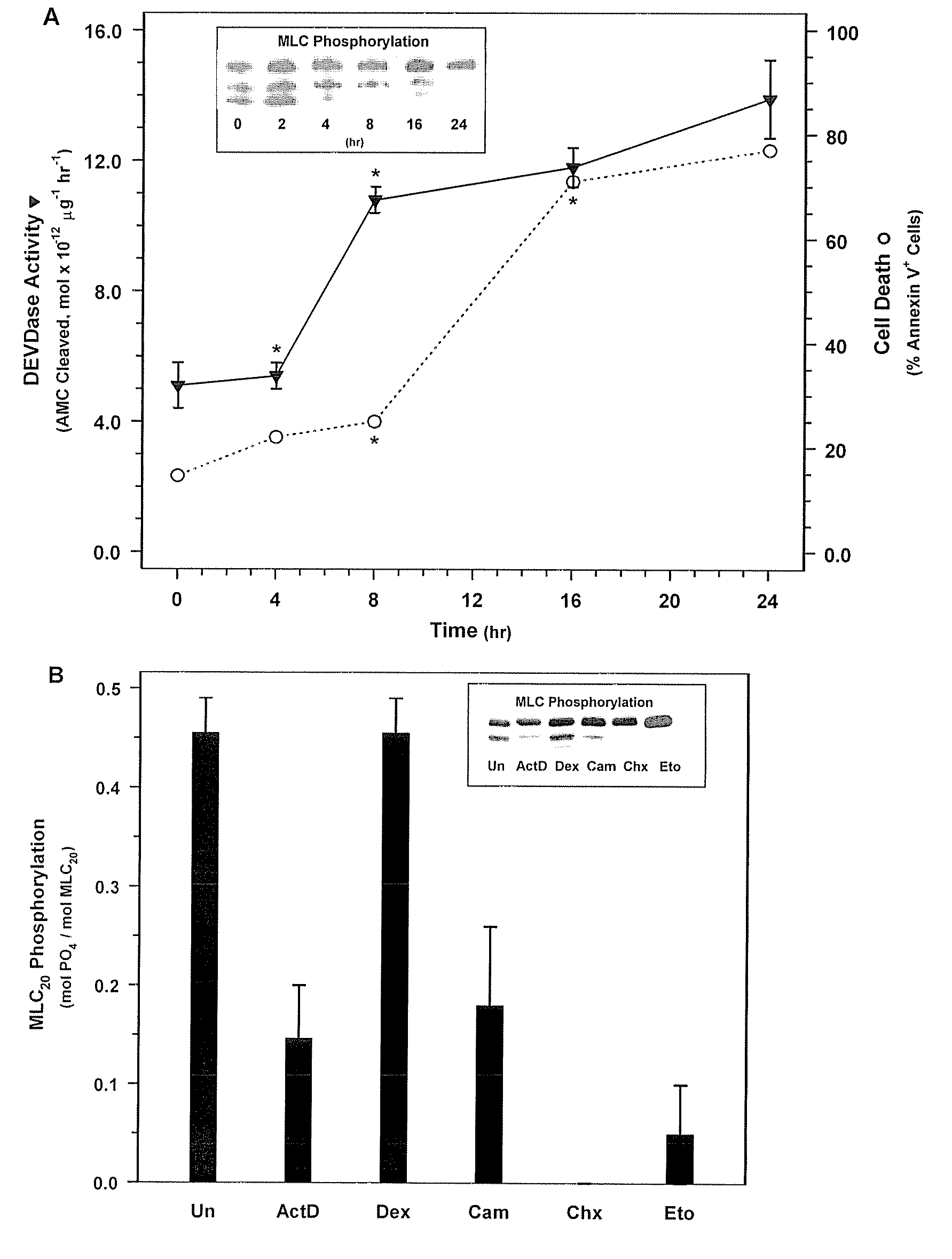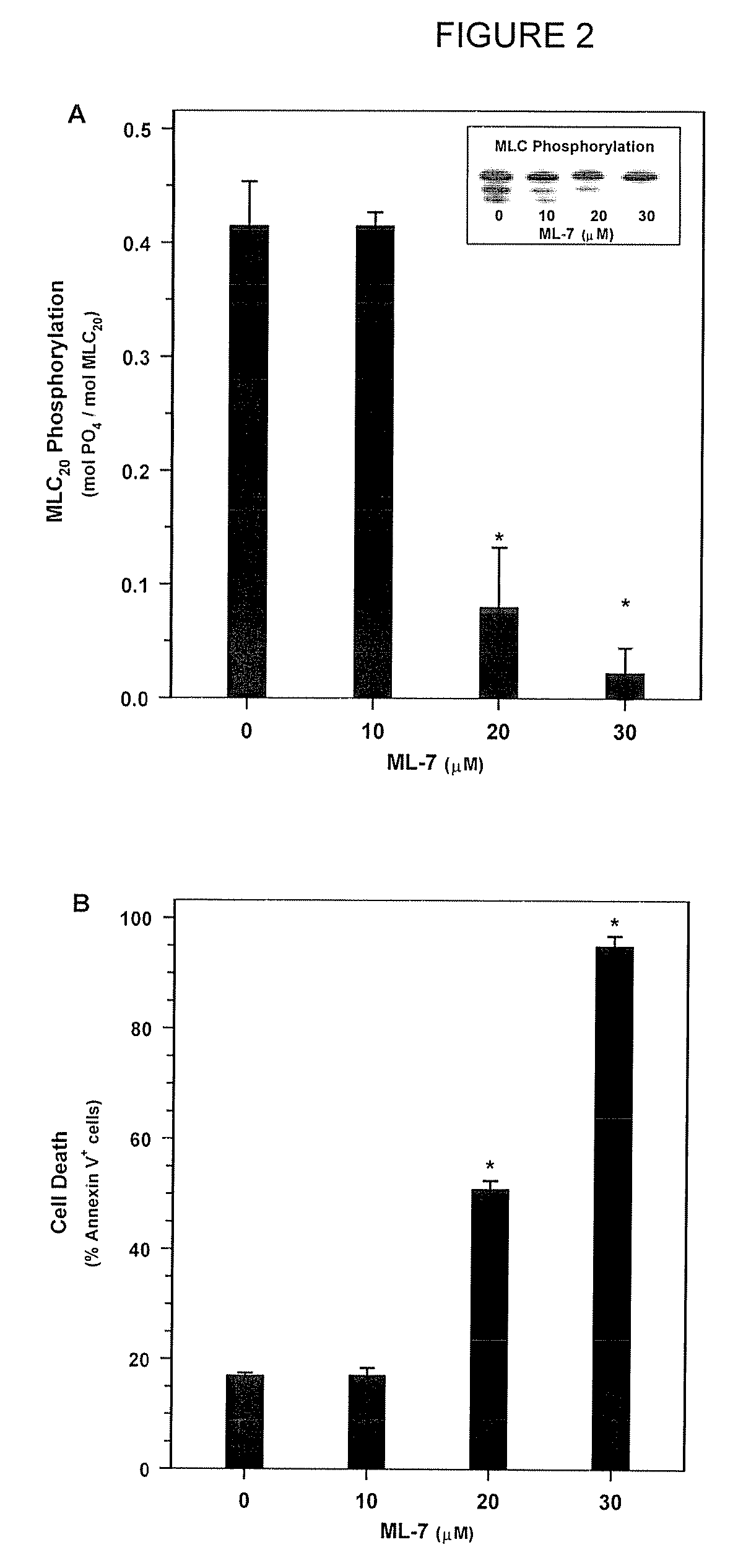Prevention of Cell Proliferation by Inhibiting Myosin Light Chain Kinase
a technology of myosin light chain kinase and cell proliferation, which is applied in the direction of nitro compound active ingredients, drug compositions, peptides, etc., can solve the problems of inability to treat tumors located in other areas such as the backbone, inability to control cell growth, and inability to use in the treatment of disseminated neoplastic conditions such as leukemia, so as to reduce the number of tumor cells, inhibit growth or proliferation, and reduce mlc-p
- Summary
- Abstract
- Description
- Claims
- Application Information
AI Technical Summary
Benefits of technology
Problems solved by technology
Method used
Image
Examples
example 1
Myosin Light Chain Dephosphorylation and Apoptosis
[0183]A. Studies with Actinomycin D
[0184]NIH 3T3 fibroblasts (ATCC Accession No. CRL-1658) were treated with actinomycin D, which is a compound known to rapidly induce cell death, to determine its effect on MLC-P.
[0185]NIH 3T3 fibroblasts were obtained from ATCC and were grown in Dulbecco's Modified Eagle Medium (DMEM) (Gibco BRL, Gaithersburg, Md.) supplemented with 10% FBS and 1% penicillin and streptomycin in a 37° C. incubator. 3T3 cells were treated with 500 nM actinomycin D in DMEM containing 0.5% FBS without antibiotics for the 0, 2, 4, 8, 16, or 24 hours. Cells were then washed with phosphate buffered saline (PBS). Floating cells were collected by centrifugation and combined with attached cells that were harvested by trypsinization. MLC20 phosphorylation was quantified be Western blotting with an anti-MLC20 antibody (FIG. 1). In short, the harvested cells were treated with ice cold 10% TCA, 10 mM DTT to precipitate the cellul...
example 2
MLC-DP Triggers Cell Death
[0190]Next, in order to determine whether MLC-DP can trigger cell death, SMC were treated with ML-7 or KT5926, two inhibitors of MLCK (Nakanishi et al., 1990; Garcia, 1998; and Bain et al., 2003). Treatment with increasing doses of ML-7 (0, 10, 20, and 30 μM concentrations) for 16 hours resulted in a dose-dependent decrease in MLC20 phosphorylation (FIG. 2A) and a corresponding increase in cell death (FIG. 2B). Similarly, treatment with KT5926 resulted in cell death, including genome digestion, in NIH 3T3 cells (data not shown). As is the case with non-muscle cells induced with actinomycin D, MLC-DP was an early event in cell death in SMC treated with 20 μM ML-7 (FIG. 3A). Thus, MLC20 dephosphorylation precedes the onset of apoptosis and inhibiting MLCK appears to be sufficient to induce cell death.
example 3
MLCK Inhibitory Antibody Triggers Apoptosis
[0191]The role of MLC-DP in apoptosis was investigated further by microinjecting SMC with an affinity purified, inhibitory antibody to MLCK (de Lanerolle, 1981). An affinity purified, goat anti-human IgG was used as a control. Each antibody was mixed separately with either rhodamine-labeled dextran or fluorescein-labeled dextran as an injection marker. Results were mean±SEM for 3 experiments (*p value <0.01 using a paired T test). FIG. 3B shows confocal images of cells microinjected with a control antibody or an affinity-purified inhibitory antibody to MLCK immediately following microinjection (Panels A, B, E, F) and 4 hrs later (C, D, G, H). The control antibody (affinity-purified goat anti-human IgG) was mixed with FITC-labeled dextran prior to injection and the MLCK antibody was mixed with rhodamine-labeled dextran.
[0192]Three to four hours after injection, the cells were scored for morphological markers of cell death without prior knowl...
PUM
| Property | Measurement | Unit |
|---|---|---|
| pH | aaaaa | aaaaa |
| pH | aaaaa | aaaaa |
| emission wavelength | aaaaa | aaaaa |
Abstract
Description
Claims
Application Information
 Login to View More
Login to View More - R&D
- Intellectual Property
- Life Sciences
- Materials
- Tech Scout
- Unparalleled Data Quality
- Higher Quality Content
- 60% Fewer Hallucinations
Browse by: Latest US Patents, China's latest patents, Technical Efficacy Thesaurus, Application Domain, Technology Topic, Popular Technical Reports.
© 2025 PatSnap. All rights reserved.Legal|Privacy policy|Modern Slavery Act Transparency Statement|Sitemap|About US| Contact US: help@patsnap.com



